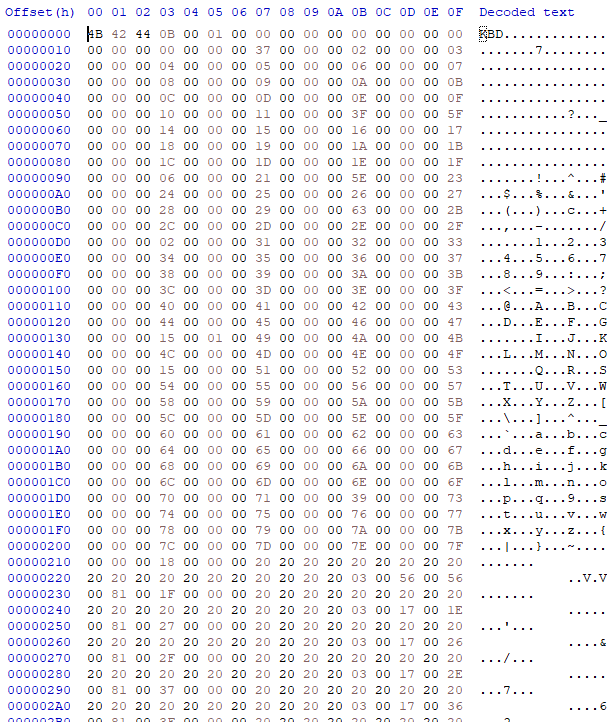Following up from last week’s misadventures with the Avant Stellar keyboard (trying and failing to extract macro information from the keyboard’s internal memory), there was another glimmer of hope: my friend found a backup file that possibly contains all the macros that were saved to the keyboard. If I could just reverse-engineer this backup, we could extract the macros directly from the file. It is a 2 KB file with a .KBD extension, unrecognizable as any binary format I’ve seen to date. Here is a partial hex dump of the file:

It’s pretty clear that the file contains a key mapping, as evidenced by the list of incrementing 32-bit numbers at the beginning, up to offset 0x210. There are roughly 120 increasing numbers, which is roughly the number of keys on the keyboard, so we can safely assume that this is the key mapping. After the key mapping, I presume, comes the macro information, and this is where things get tricky, since there’s virtually no way to tell how the macros are encoded in the file. The data simply looks too general to make sense of.
An obvious possibility would be to “load” the backup file into the Avant software tool that came with the keyboard, and visually inspect the macro(s) assigned to each key. But no matter what I tried, the software would not load the file. Or rather, it loaded the key mapping, but not the macros. Time to think about the nuclear option: disassemble the Avant software and see how it’s actually processing the backup file.
Looking at the folder contents of the Avant software tool, I immediately notice a dead giveaway: VBRUN300.DLL, which means this tool was written in Visual Basic 3.0. This makes our job much easier, because there are actually ready-made tools for decompiling Visual Basic executables. (If you recall, Visual Basic compiles executables into p-code instead of native machine code, which makes them much more straightforward to decompile.) All of this took me quite a while to remember, because I hadn’t used these tools since my early, early hacking days, and it took a little while longer to find them in my archives! The go-to utility for performing this task was literally called VB3 Decompiler, and the way to find this tool on the web today is… outside the scope of this post.
The decompilation basically results in several Visual Basic source files, in which the original function names are intact, but the local and global variables are changed to generic identifiers, since those names are not stored in the compiled code. It takes a little bit of further massaging to get these files to actually build within Visual Basic, but after that, it’s almost as if you have the original source code of the program at your fingertips.
There was one other minor hurdle because the Avant software uses custom UI components (.VBX files) that don’t allow themselves to be used in Design mode (as part of a copy-protection or licensing mechanism), but this is bypassable using another utility in the decompiler suite that “fools” Visual Basic into loading the components anyway.
With the source code buildable and debuggable, we can now easily run the program and load the .KBD backup file, and trace through where it processes the data in the file:

Even though the variable names aren’t very descriptive in the above screenshot, it’s easy enough to spot the loop that deserializes the keyboard macros, and how each macro is composed. Not only that, but we can determine what was preventing it from displaying the macros in the first place – it turned out that it expects the keyboard to be physically connected while running, and while I’m pretty sure that we tried loading the backup with the keyboard attached, it wasn’t working anyway, probably because the keyboard is malfunctioning and no longer able to communicate properly. But at last, with this requirement bypassed, the macros that were loaded from the backup file finally reveal themselves:
